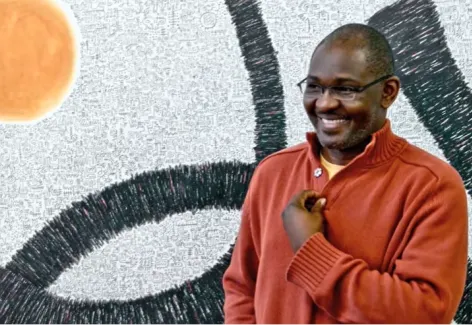Nigerian-born artist Victor Ekpuk is best known for his improvisational use of nsibidi, a form of ideographic writing associated with the powerful Ekpe men’s association of southeastern Nigeria.
Sponsored in part by Krannert Art Museum and partially supported by a grant from the Illinois Arts Council
As a student of fine arts at Obafemi Awolowo University in Ife in the mid-1980s, Ekpuk worked in a pedagogical environment informed by onaism, a Yorùbá aesthetic philosophy that urged students to explore the logics of pattern and design in indigenous African art forms. Ekpuk’s early fascination with nsibididuring these years—its economy of line and encoded meanings—led to his broader explorations of drawing as writing, and to the invention of his own fluid letterforms. As a mature artist, Ekpuk has so internalized the rhythm and contours of his “script” that it flows from his hand like the outpouring of a personal archive.
In recent years, Ekpuk’s approach to mark making has come to flourish through his investigations of scale, motion, surface, and form. Auto-Graphics features selections from several of Ekpuk’s new bodies of work, including collage, digital prints, and his large scale drawings—bold, vibrant, yet restrained compositions in which nsibidi signs are cropped, abstracted and glided out of sight through the illusion of magnification. Their dense grounds of micro-stories and bristling opaque forms contrast with the figural, more cursive works on view.
Ekpuk’s compositions are not tentative or ambivalent, and are drawn with no erasure. Like nsibidi, which communicates through both visual mark and gesture, Ekpuk’s immersive drawings seem to be choreographed with the full force of his body. This will become readily evident to visitors when, upon entering the museum, they are greeted by one of Ekpuk’s ephemeral works drawn directly onto the gallery wall—an ample surface on which to explore the infinite potential of the hand-drawn line.
KAM video | Postscripts: Art of Victor Ekpuk
Curator: Allyson Purpura





